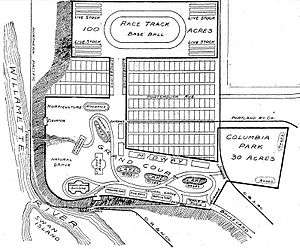University Park, Portland, Oregon
| University Park | |
|---|---|
| Neighborhood | |
|
| |
 University Park | |
|
Coordinates: 45°34′44″N 122°44′13″W / 45.579°N 122.737°WCoordinates: 45°34′44″N 122°44′13″W / 45.579°N 122.737°W PDF map | |
| Country | United States |
| State | Oregon |
| City | Portland |
| Government | |
| • Association | University Park Neighborhood Association |
| • Coalition | North Portland Neighborhood Services |
| Area | |
| • Total | 1.20 sq mi (3.10 km2) |
| Population (2000)[1] | |
| • Total | 5,250 |
| • Density | 4,390/sq mi (1,694/km2) |
| Housing[1] | |
| • No. of households | 1692 |
| • Occupancy rate | 95% occupied |
| • % households renting | 27% renting |
| • Avg. household size | 3.10 persons |
University Park is a neighborhood in the north section of Portland, Oregon on the east shore of the Willamette River. University Park is bounded by North Lombard Street and the Portsmouth neighborhood to the north, North Chautauqua Boulevard and the Arbor Lodge neighborhood to the east, The Willamette River and Mock's Bottom industrial area to the south, and the North Portland railroad cut with Cathedral Park and St. Johns neighborhoods to the west.
The neighborhood is home to an 11.26-acre (4.56 ha) North Portland park of the same name, land for which was acquired in 1953.[2]
History
University Park was named for its proximity to the former Portland University, a Methodist institution founded in 1891.[3] Property of 71 acres for the university and roughly 530 acres for the surrounding neighborhood was platted from land owned by pioneer families and sold at half-value to the Methodist Episcopal Church, then owners of Willamette University in Salem. The church planned to sell individual lots through a realty company in University Park to finance the university, but home site sales did not sustain the institution.[4] A financial failure for most of its brief existence, the university closed in 1900.[5]
After Portland University closed, the land and buildings were purchased by the Archdiocese of Portland in 1901, and Columbia University[6] opened on the site, later renamed the University of Portland. Public transportation was installed, and industry began to develop in the area.

As designers of University Park, Methodist Episcopal officials aligned streets along a northeast – southwest axis and a northwest – southeast axis in order to maximize exposure to sunlight. Church officials also chose street names in remembrance not only of institutions of higher learning but also persons and places important to Methodists of the time. As a result, University Park is a neighborhood without an ordinal relationship among streets; therefore, navigation requires knowledge of all streets.[4][7]
Parks, sports venues and natural areas
- Chiles Center
- Columbia Park Annex
- Joe Etzel Field
- Louisiana-Pacific Tennis Center
- McKenna Park
- Merlo Field
- Portsmouth Park
References
- 1 2 Demographics (2000)
- ↑ "University Park". Portland Parks & Recreation. Retrieved 2013-04-23.
- ↑ "The Portland University, Located in This City". The Oregonian. Portland: Henry Pittock. January 1, 1895. p. 29. Retrieved February 12, 2015.
- 1 2 Snyder, Eugene E. (1979). Portland Names and Neighborhoods. Portland: Binford and Mort. pp. 31–37. ISBN 978-0832303470.
- ↑ "Close of Portland University". The Oregonian. Portland: Henry Pittock. May 17, 1900. p. 7. Retrieved February 12, 2015.
- ↑ No affiliation with Columbia University in New York.
- ↑ For example, Portland's Alphabet District has numbered avenues along a north – south axis and alphabetized streets along an east – west axis that form a grid where navigation only requires knowledge of the order of numbers and letters.
External links
| Wikimedia Commons has media related to University Park. |
- Map of University Park streets and boundaries, a downloadable PDF file from the City of Portland